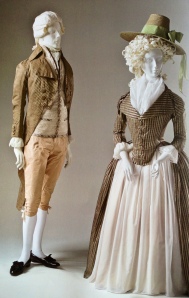Whilst showing my friend Kimberley images of the waistcoats below she exclaimed ‘these were worn by men? They’re very girly!’
Indeed the rich embroideries, jewelled and sequinned designs of eighteenth century waistcoats would most certainly be considered appropriate for the sartorial predilection of the raffish dandy today, but certainly not every man.
Althea Mackenzie writes in her book, Embroideries, that an eighteenth century gentleman of style might have as many as 300 waistcoats in his wardrobe, all richly embellished with decorative motifs and sparkle. The incredible designs would have likely to have been produced either by an embroidery workshop or by the ladies and/or servants of the house.
As I mentioned in my last post these waistcoats were often worn with coats of similar design, cut to expose the craftsmanship of the waistcoat. In France during the very last years of the eighteenth century the cut of a coat affected the wearers gait by forcing the wearer to stand unnaturally erect, with his chest thrust forward. This affect was achieved by stitching the shoulders unnaturally close together. By adding waistcoats and cravats this accentuated the desired silhouette the wearer was trying to achieve.

In the closing years of the eighteenth century, French fashion extremists who adopted this mode of dress were given the moniker incroyables. It was viewed in this context as a subversive reaction to the understated modes of dress adopted by the surviving aristocracy after the zenith of the French Revolution.
In her essay, Fashioning (and refashioning) European Fashion, Kimberley Chrisman-Campbell states: ‘[waistcoats] were sartorial vehicles for personal expression and identity’
Some fabulous examples of this can be seen in the late eighteenth century waistcoats from the Snowshill collection that invite you to imagine the flamboyance, and wealth, of its wearer.
I have included the detail from the accompanying conservation records below.
The front of this waistcoat is made of cream, finely ribbed silk. Both the reverse and lining material comprise of cream silk twill. The interior lining also has a cream linen back.
In the conservation record the cut of the waistcoat is described as follows;
Date: 1780-90
Cut: Foreparts skirt cut back; ovelapping side vents. Single-breasted; buttonholes and possibly buttons from neck to point of divergence; 2 sets of tapes sewn on back; shaped and scalloped pocket flaps. Pierced on shoulders.
Trimmings: Embroidered all over with silk in a design of flowers and scales in lilac and sky green; foreparts and pockets in matching round with braid.
Fastenings: Only two original buttons remain, both on left pocket (1 missing); 3 buttons missing from right pocket. The 5 metal buttons with Alpha-type shanks are later additions. 11 buttonholes, of which two are uncut. The original buttons are silk covered and embroidered.
Note the neckband of the following two garments below have had the neckband altered in a way which could suggest more than one owner, or more likely, the wearer putting on weight.
Date: 1775-85
Front: Ivory fancy ribbed sink
Back: Cream linen
Cut: Skirts diverge at waistline; overlapping side vents, buttons and holes from 4″/10.2cm below neck to point of divergence; horizontal pocket flaps, 2.5″/6.4 cm collar, stepped. 3 pairs of tapes across back.
Trimmings: Sprays of flowers and leaves embroidered in multicoloured silks and silver purls and sequins on leading edges and pocket flaps; single flowers embroidered overall
Fastenings: 11 fabric-covered buttons, embroidered with silk in a sunburst design
Alterations: Neckband has been let out
Cut: Skirts diverge at midline; overlapping side vents, Buttons and holes from 2.5″/6.4cm below neck to point of divergence; 2 3/4 or 7cm high collar; horizontal pocket flaps, pocket slit is straight and not curved; 2 pairs of tapes across centre back
Trimmings: Running sprays of leaves on running edges, pocket collar flaps and collar embroidered with silks in browns, gold and creams; also flowers embroidered overall
Fastenings: 8 buttons (2 missing), silk covered and embroidered, (1 uncovered in pocket and made of bone)
Date: 1775-80
Front: Silver Lamè fabric (silk)
Back: Cotton
Lining: foreparts only silk twill
Cut: Skirts diverge from below waist; overlapping side vents; buttons and holes neck point to point of divergence; 13/4/4.5cm high collar. Stepped pocket flap, curved at top. Pair of tapes across back at waist level
Trimmings: Running sprays of leaves in gold purl, passing and sequins on leading edges and round and on pockets; also sprays of rosebuds and leaves embroidered with silk; silk embroidered leaves overall
Fastenings: 12 + 3 buttons on each pocket. Silk embroidered with sequins on silver lamè fabric
Date: 1780-90
Fabric Front: Cream silk tabby
Back: Cream linen
Lining: Silk twill facings; linen lining “Mrs Vansitart” written in ink on right back
Cut: Skirts diverge at waistline; slightly overlapping side vents; buttons and holes neck to point of divergence (top buttonhole uncut); horizontal pocket flaps; 2 1/4″ / 5.7cm collar, stepped. 2 sets tapes across back
Trimmings: Embroidered with silk in a design of oak leaves and acorns (in greens and browns) down leading edges, collar and pocket flaps. Also green/brown spots embroidered overall
Fastenings: 12 fabric covered, embroidered buttons (inferior quality)
Sources:
Ashelford, Jane. The Art of Dress: clothes through history, 1500 – 1900. London: The National Trust, 1996.
Chrisman-Campbell, Kimberley. Fashioning Fashion; European Dress in Detail, 1700-1795. DelMonico Books, Los Angeles County Museum of Art, 2011.
Mackenzie, Althea. Embroideries, London, The National Trust, 2004.



















































Can you tell me, is the essay you mention (“Fashioning and re-Fashioning..”) published somewhere?
LikeLike
Yes it is in this fabulous book: Fashioning Fashion: European Dress in Detail, 1700-1915. Its worth getting!
LikeLike